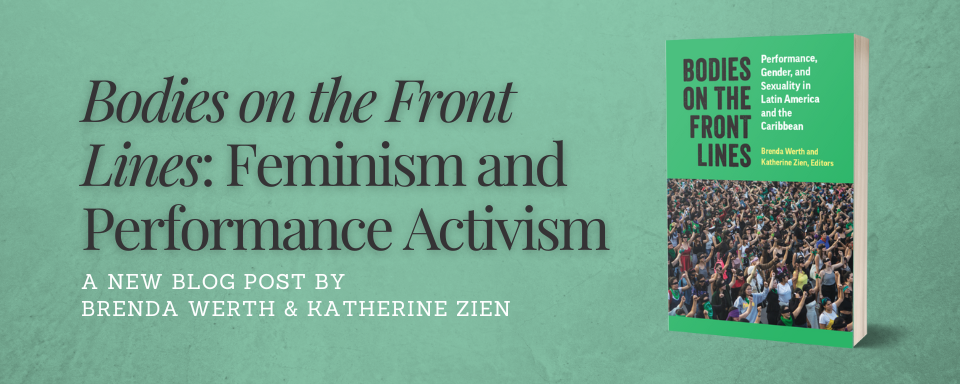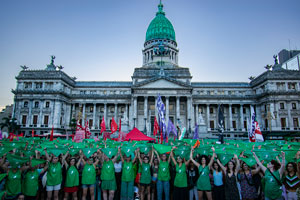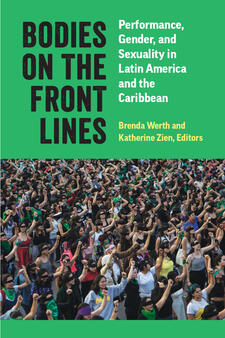Bodies on the Front Lines: Feminism and Performance Activism

This guest post is by Brenda Werth & Katherine Zien, co-editors of Bodies on the Front Lines: Performance, Gender, and Sexuality in Latin America and the Caribbean, which is now available in hardcover, paperback, and open access.
Six years ago, when we began thinking about this book, feminist mobilization in Argentina was at a peak, following the 2015 #NiUnaMenos marches against femicide and gender violence, and the Green Tide movement demanding legal, safe, and free access to abortion. In Chile, a feminist collective of five queer artist-activists from Valparaíso named LASTESIS had just performed the flashmob “A Rapist in Your Path” for the first time on the streets of Santiago. In the U.S., the #MeToo (2018) movement had exploded. All of these events helped draw attention to systemic gender violence and showcased new strategies for engaging in activism through direct, embodied protest on the streets and digital action via hashtags and other media platforms.
We started to notice, in mainstream Western journalism, the assumption that #MeToo had traveled from the US to Latin America (for example, “#MeToo is at a crossroads in America. Around the world, it’s just beginning.” Washington Post, 8 May 2020). This claim simplified the colonial politics at play and ignored the fact that gender and sexuality activists in Latin America had been organizing against, analyzing, and protesting gender violence for decades, through movements that have developed both autonomously and in coalition with organizations and state institutions.
Therefore, one of our major goals in this book is to foreground the deep, shifting lineages of feminist performance activism that have originated in Latin America and the Caribbean. While #NiUnaMenos and “A Rapist in Your Path” have been some of the most visible and globally disseminated performance protests, we wanted to contextualize these movements and place them in transnational dialogue with Afro-diasporic and Indigenous feminisms across Latin America and the Caribbean. We were eager to highlight for readers the extraordinary breadth, depth, and nuances of performance and activism to advance and defend gender and sexuality rights.
The twenty collected essays included in this book examine contemporary performances in Mexico, transnational Central America, Peru, Colombia, Brazil, Chile, Argentina, Cuba, Puerto Rico, and the Dominican Republic. They expand and broaden our understanding of how performance has informed activist practices across the region, and they take stock of the interweave of activism, performance, and gender and sexuality politics amid a complex, evolving relationship between embodied acts and digital media (Fuentes 2019; Taylor 2003). Contributors to the book discuss a continuum of performances, from theater to street and digital protests, including feminist murgas (Borzone, Argentina); transloca rituals (Fountain-Stokes, Puerto Rico); Afro-Cuban drag king cabaret, and Xicanx art (Herrera and Méndez, Cuba).
The book stresses the instrumentality and relevance of performance studies as an approach to studying protest forms that are embodied, choreographed, live, and digital, and show artists and activists “putting their bodies on the line” (poner el cuerpo), as argued by Barbara Sutton (2010) and Victoria Fortuna (2019). In our book, we define performances as citational acts, or practices of repeated behavior, that draw upon embodied repertoires to perpetuate, challenge, and draw attention to political and social issues. Performance practices involve constellations of digital and ‘live’ actions, as well as relations among bodies, spaces, and temporalities. In taking time to gather in space, amassed protesters affirm their embodied presence as a testament of their rage, sadness, joy, desire, and hope. These gatherings do not replace other important acts by which political change becomes possible; they do not by themselves make political change happen. Many performances are ephemeral: their overarching impact is unclear, their futures unknown. But they register a certain relationship to time, space, affect, and politics – one that matters. As performance scholars, we engage these multidirectional acts as events that make meaning, however unstable, and that inspire further enactments on local, national, and international scales.
In considering the ways that performances matter, we foreground several conceptual and methodological approaches: creating critical “counter-publics;” employing tactics of disidentification vis-à-vis normative mainstream culture and media; spectacular acts of refusal to assimilate or adhere to Global North gender and sexual identity categories; and creating and sustaining micro-communities of care in the absence of state support. Disidentification and the creation of critical counterpublics are both key performance tactics of survival for minoritarian racial, gendered, and sexual subjects, as José Muñoz (1999) and Michael Warner (2010), among others, have argued.
Our book examines political, social, aesthetic, and affective uses of theater and performance in digital and live spaces, and we stress that these modes do not belong exclusively to the Left. In fact, recent performances in Argentina provide a chilling example of how greatly performance tactics deployed by the Right matter. The explosion of feminist mobilization that took place between 2015 and 2020, fueling Argentina’s landmark decision to legalize abortion in December 2020, is now rivaled by burgeoning counter-performances under new ultra-Right, self-professed “anarcho-capitalist” President Javier Milei.
Here is one example of such public acts: the Milei government chose March 8th, 2024 (International Women’s Day) to announce via Twitter/X the closure of the Salón de Mujeres (Women's Hall) and the Antesala de Mujeres, Géneros y Diversidad (Women, Genders, and Diversity Hall) in the Casa Rosada and replace them with a new Salón de Próceres (Heroes' Hall). Seventeen portraits of women and LGBTQIA+ activists were removed and replaced by a patriarchal lineage of founding fathers and independence fighters. This act was intended to energize Milei's base, provoke feminist groups, and assert a nationalistic, militaristic, and normative vision of the nation. Both the total erasure of homage to women and gender and sexual minorities and the complete omission of leaders upholding the country's democratic heritage generated outrage, part of the ongoing call-and-response of gender and sexual performances that play out in public.
Our book thus enters the world at a critical juncture: Covid-19 is not yet a distant memory, and the new global ultra-Right is emerging, with renewed threats to the gains that feminists have made in advancing gender and sexuality rights across Latin America and the Caribbean. In our book, we center the digital and enfleshed actions that put bodies on the line (poner el cuerpo) to do politics in myriad ways. These bodies sometimes escape history, statistical enumeration, or studies of political change. We may only know them as lines chalked out on the sidewalk, unidentified handkerchiefs, bared chests and backs captured in photographs – as broken URLS and dead-end links that once conveyed information about a manifestation – as graffiti traces on restored monuments. These bodies may remain nameless and unfollowable as they move around the city and pop up on our screens. Yet these are also bodies on the front lines in the ongoing assault on transversal feminisms. In attending to their performances of defiance and dedication, we can become careful witnesses to a sensuous array of micropolitical relationships asserted at the level of the eye, ear, and flesh.



